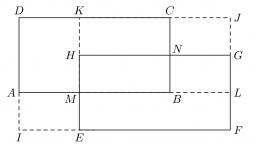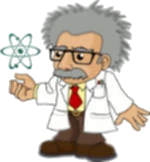MO8-Z8-I-5 2017
Identical rectangles ABCD and EFGH are positioned such that their sides are parallel to the same. The points I, J, K, L, M, and N are the intersections of the extended sides, as shown. The area of the BNHM rectangle is 12 cm2, the rectangle MBCK area is 63 cm2, and the rectangle MLGH area is 28 cm2. Find the area of the IFJD rectangle.
Correct answer:

You need to know the following knowledge to solve this word math problem:
Units of physical quantities:
Themes, topics:
Grade of the word problem:
We encourage you to watch this tutorial video on this math problem: video1
Related math problems and questions:
- Connecting 83441
 They are given a square ABCD. The points EFGH are the midpoints of its sides. What part of the content of the square ABCD is the content of the square created in its center by connecting the points AF, BG, CH, and DE?
They are given a square ABCD. The points EFGH are the midpoints of its sides. What part of the content of the square ABCD is the content of the square created in its center by connecting the points AF, BG, CH, and DE? - Rectangles: 3540
 The dimensions of the left rectangle are 4 cm and (x+1) cm. The right rectangle consists of two rectangles: the upper one with dimensions of 3 cm and x cm and the lower one with an area of 7 cm². We know that the area of the left rectangle is the same as
The dimensions of the left rectangle are 4 cm and (x+1) cm. The right rectangle consists of two rectangles: the upper one with dimensions of 3 cm and x cm and the lower one with an area of 7 cm². We know that the area of the left rectangle is the same as - Trapezium ABCD
 The figure shows ABDC is a trapezium in which AB || CD. Line segments RN and LM are drawn parallel to AB such that AJ=JK=KP. If AB=0.5m and AP=BQ=1.8m, find the lengths of AC, BD, RN, and LM. angle D=angle C=60
The figure shows ABDC is a trapezium in which AB || CD. Line segments RN and LM are drawn parallel to AB such that AJ=JK=KP. If AB=0.5m and AP=BQ=1.8m, find the lengths of AC, BD, RN, and LM. angle D=angle C=60 - Calculating 32483
 Divide a rectangle with 60mm and 84mm sides into three rectangles with the same perimeter draw by calculating. Find the dimensions of the rectangles after division.
Divide a rectangle with 60mm and 84mm sides into three rectangles with the same perimeter draw by calculating. Find the dimensions of the rectangles after division.
- Rectangular 81233
 A rectangular strip of paper measuring 4 cm x 13 cm is folded as shown. The two resulting rectangles have areas P and Q, where P = 2Q. Calculate the value of x. Note divide the side of 13 cm by x and 13-x.
A rectangular strip of paper measuring 4 cm x 13 cm is folded as shown. The two resulting rectangles have areas P and Q, where P = 2Q. Calculate the value of x. Note divide the side of 13 cm by x and 13-x. - Peter's rectangle
 Peter had a rectangle 2 cm wide and of unknown length. The line had a 2 cm rectangle whose length was equal to the perimeter of Peter's rectangle. When they put the rectangles together with their widths, they got a new rectangle with a circumference of 63
Peter had a rectangle 2 cm wide and of unknown length. The line had a 2 cm rectangle whose length was equal to the perimeter of Peter's rectangle. When they put the rectangles together with their widths, they got a new rectangle with a circumference of 63 - Parallelogram
 Calculate area of the parallelogram ABCD as shown if |AB| = 13 cm, |BC| = 99 cm and angle BAD = 100°
Calculate area of the parallelogram ABCD as shown if |AB| = 13 cm, |BC| = 99 cm and angle BAD = 100°
